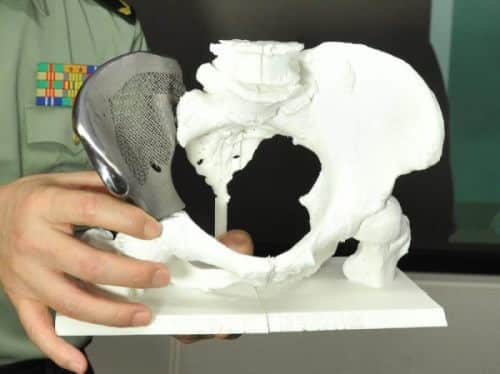Engineers have succeeded in developing an ink for a XNUMXD printer that enables the production of synthetic bone implants that encourage the regrowth and development of bone cells. This bone material, whose structure can be easily adjusted, could one day be useful for the treatment of bone defects in children, for example.

[Translation by Dr. Nachmani Moshe]
Engineers have succeeded in developing an ink for a XNUMXD printer that enables the production of synthetic bone implants that encourage the regrowth and development of bone cells. This bone material, whose structure can be easily adjusted, could one day be useful for the treatment of bone defects in children, for example.
Engineers from Northwestern University have succeeded in developing a XNUMXD printer ink that enables the production of synthetic bone implants that encourage the regrowth and development of bone cells. Bone grafting surgery is never a simple surgery, and it is painful and complicated especially when it is done in children. For both children and adults, the transplanted bone intended to replace the missing bone is often taken from another area of the body, a necessity that may cause complications and pain elsewhere in the body. Metal implants are often used, but this solution is not a permanent solution for growing children. "Adults have more options in terms of implants," said lead researcher Ramille N. Shah. "When the patients are children, this is not the case. If a permanent implant is chosen, then additional surgeries should be performed in the future as they grow older and the body grows. In these cases, the children may experience years of difficulties and pain."
The researcher, and her research team, wanted to change the nature of bone implants, and especially help child patients. The new study, which examines the effectiveness of the substance in the framework of human touch cells as well as in models of EB, was published in the scientific journal Science Translational Medicine. The research team's innovative material is a bio-material consisting of a mixture of hydroxyapatite (a calcium salt found naturally in human bones) and a bio-degradable polymer suitable for the body that is used in many medical applications, including sutures. The new material showed good performance in models of BH in living systems, where its success lies in the unique features of the structure printed with it. "Porosity is a very important factor when it comes to tissue regeneration, since we want the cells and blood vessels to penetrate into the scaffolds and grow there," explains the lead researcher. "Our three-dimensional structure has varying levels of porosity, which is a great advantage in terms of physical and biological properties."
![Cross section of a XNUMXD printed human femur [Courtesy: Adam E. Jakus, Northwestern University]](https://www.hayadan.org.il/images/content3/2016/10/3d-printed-bone-b1.jpg)
Although it has already been proven that hydroxyapatite succeeds in inducing bone regeneration, working with it is very challenging. Clinical products based on hydroxyapatite or other ceramic materials composed of calcium phosphates are hard and brittle. In order to compensate for this, previous studies made use of structures composed mainly of polymers, but this polymer layer masks the activity of the biomaterial. The new material, however, consists of 90% hydroxyapatite and only 10% polymer, while still maintaining its flexibility thanks to the design of the structure and the way it is printed. The high concentration of hydroxyapatite creates a favorable environment for rapid induction of bone regeneration.
"The cells can sense the presence of the substance hydroxyapatite and react to it," explains the researcher. "When stem cells are placed on the scaffolds we created, they quickly become bone cells and begin to regulate the specific genes responsible for creating bone cells. This is without the addition of other substances that encourage bone growth. This result is obtained thanks to the interaction between the cells and the material itself only." Another advantage lies in the fact that other materials can be integrated into the XNUMXD printing process. Given the fact that the printing process is carried out at room temperature, the researchers were able to incorporate other substances, such as antibiotic substances, into the ink itself. "The combination of antibiotic substances is important to prevent possible infection during the insertion of the implant itself," explains the researcher. In addition, the researchers will be able to combine additional substances such as growth factors to encourage even more efficient and faster growth of the bone cells. "Our new material is really multifunctional," the researcher notes.
And after all the above, one of the biggest advantages is the ability to personally adjust the finished product to the patient. In normal bone graft surgeries, the bone - after being taken from another part of the body, needs to undergo structural changes and repairs so that it fits precisely into the surgical area. Now, with the new synthetic material, doctors will simply scan the patient's body and XNUMXD print the missing part precisely. Alternatively, thanks to its mechanical properties, it will be possible to cut the finished biomaterial to the desired shape and size within the procedure itself. Not only is the method faster, it also prevents the pain associated with removing bone parts from the body. The researcher predicts that in the future hospitals will be able to print the missing part precisely adapted to the patient being operated on, while it waits in line.

One response
"Shoulder bone graft"??? Look!
Besides, whoever holds the implant model probably participated in 15 important battles against his own people according to the medals. In China it is easier to get a custom made bone graft than a death sentence that has the right dimensions. And if the person in need of a transplant is the son of one of the important (or a foreign citizen with a lot of money), it is probably also possible to make someone of the right degree be sentenced to death.